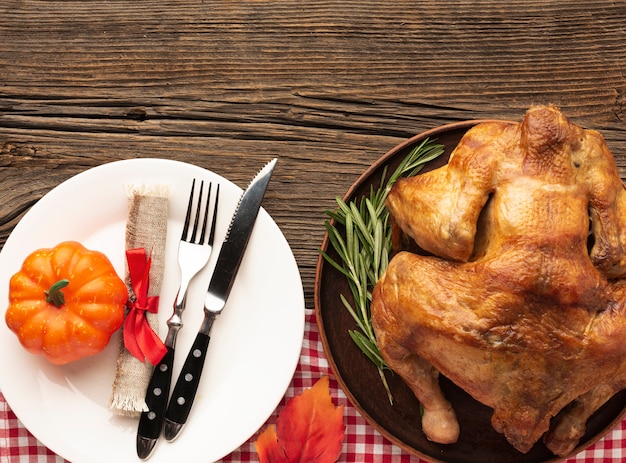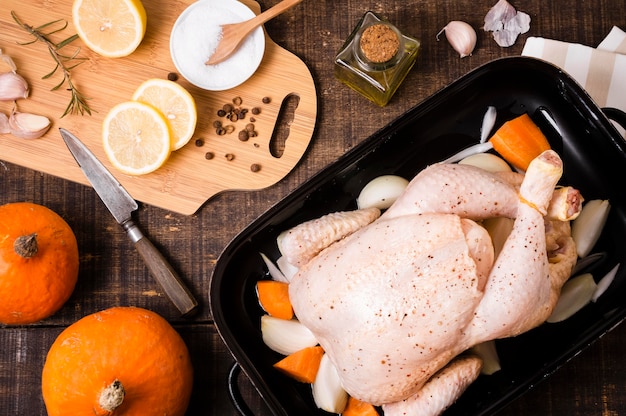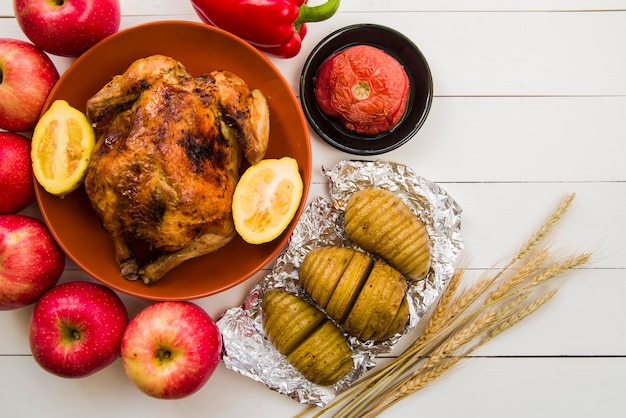(Part 1) What is Spatchcocking?

If you’re not already in the know, spatchcocking is basically the culinary term for flattening a turkey. You remove the backbone, then press the turkey flat, transforming it from a bulky bird into a flat, roasting-friendly masterpiece. It’s like a turkey makeover!
Why Spatchcock a Turkey?
Let me tell you, this spatchcocking business is a total game-changer. It’s like a secret weapon for turkey cooks, and once you’ve tried it, you’ll never go back.
- Faster Cooking: This is the big one! Spatchcocking significantly cuts down on cooking time. We're talking a good hour or two less, which means you can spend less time in the kitchen and more time enjoying your holiday feast.
- Evenly Cooked Bird: Flattening the turkey exposes every bit of it to the heat, ensuring even cooking from breast to legs. No more dry breasts or undercooked legs – just a beautifully cooked bird, every time!
- crispy skin: With the skin exposed, it gets nice and crispy. That golden-brown, crispy skin is the key to unlocking a whole new level of flavour. It’s a culinary dream come true.
- Easier Carving: Forget the struggle of carving a whole turkey. Spatchcocking makes carving a breeze. It’s simple, straightforward, and even novice carvers can tackle it with confidence.
(Part 2) Spatchcocking Your Turkey: A Step-by-Step Guide

Okay, now you’re ready to spatchcock your turkey. Don’t worry, it’s easier than it sounds!
Step 1: Gathering Your Tools
Before you get started, you’ll need a few tools:
- Sharp Chef's Knife: A good quality knife is absolutely essential. Invest in a good one if you don’t already have one. You’ll thank me later!
- Cutting Board: Choose a board that’s large enough to accommodate your turkey comfortably.
- Kitchen Scissors: These are handy for removing the backbone.
- Heavy Object: A large skillet or a cast-iron pan is perfect for pressing the turkey flat. If you don’t have one, try a few heavy books or a sturdy cutting board.
Step 2: Prep Your Turkey
Pat the turkey dry with paper towels. This is important for getting a crispy skin. It also helps prevent steam buildup, which can lead to soggy skin.
Step 3: Removing the Backbone
Here's the hands-on part:
- Position the Turkey: Lay the turkey on its breast side, facing you.
- Find the Backbone: Locate the backbone and carefully run your knife along either side of it, separating it from the rest of the turkey. It’s like you’re cutting along the spine. Don’t worry if you can’t get it all in one go, you can always go back and make a couple of smaller cuts.
- Remove the Backbone: Gently lift the backbone away from the turkey. You can save this for making broth later, or discard it.
Step 4: Flattening the Bird
Time to flatten your turkey:
- Flip the Turkey: Flip the turkey over so it's lying on its back.
- Press for Flattening: Place your heavy object on top of the turkey and press down firmly, ensuring the legs are pointed in opposite directions. The aim is to get the bird as flat as possible, so don't be shy about applying some pressure!
- You've Got a Flat Bird: You should now have a beautiful, flat turkey ready for roasting.
Step 5: Tucking the Wings
Tuck the wings behind the turkey, making sure the wing tips are tucked under the breast. This helps ensure even cooking and keeps those delicious wings from burning.
(Part 3) Preparing the Turkey: Brining, Seasoning, and More

Now that your turkey is spatchcocked, it’s time to prep it for roasting!
Brining or Not Brining?
This is where the turkey cook's debate rages on! Brining, which involves soaking the turkey in a salt solution, is a popular method for achieving an extra juicy and flavorful bird. However, I find that spatchcocking does a great job of ensuring juiciness and flavour all on its own, so I typically skip the brining step. It's a matter of personal preference! If you decide to brine, I recommend a simple salt brine or a brine with a touch of citrus or herbs for extra flavour.
Seasoning for Flavor
Time to unleash your creativity! The possibilities for seasoning your spatchcocked turkey are endless:
- Basic: A simple rub of salt, pepper, and garlic powder is surprisingly delicious.
- Herbed: Mix in some dried herbs like rosemary, thyme, sage, and oregano for a classic flavour.
- Citrusy: Lemon and orange zest add a vibrant, refreshing flavour.
- Spicy: For those who like a bit of heat, try adding paprika, cayenne pepper, or chili flakes.
- Sweet and Savory: Honey, brown sugar, and spices like ginger, cinnamon, and nutmeg make a delicious combination!
Remember to season generously! Season both under the skin and on top. It’s always better to have a bit too much seasoning than too little.
(Part 4) roasting time!
Now comes the exciting part: the roasting.
Preheat Your Oven
Preheat your oven to 180°C/350°F. This is a good general temperature for roasting a spatchcocked turkey.
Roasting the Turkey: Rack vs. Baking Sheet
There are a couple of ways to roast your spatchcocked turkey:
- On a Roasting Rack: Place the turkey on a roasting rack set inside a large roasting pan. This allows air to circulate around the turkey, helping it to cook evenly and achieving that lovely crispy skin.
- On a Baking Sheet: If you don’t have a roasting rack, you can place the turkey directly on a baking sheet. Just make sure to lift the turkey up off the sheet by placing something underneath the breast, like some halved onions or carrots. This helps ensure the turkey cooks evenly and prevents the breast from getting soggy.
Cooking Time: A Guide for Spatchcocked Turkeys
Here’s where we get into the specifics of turkey roasting.
Cooking Time:
| turkey weight | Cooking Time |
|---|---|
| 3-4 lbs | 1 ?? - 2 hours |
| 4-5 lbs | 2 - 2 ?? hours |
| 5-6 lbs | 2 ?? - 3 hours |
| 6-7 lbs | 3 - 3 ?? hours |
These are just general guidelines, and your cooking time may vary depending on your oven, the size of the turkey, and your desired level of doneness. Remember, it’s always a good idea to check for doneness before you consider the turkey ready.
(Part 5) Checking for Doneness: Avoiding Dry Turkey
Nobody wants a dry, overcooked turkey, so checking for doneness is crucial!
Temperature Testing: The Reliable Method
The most reliable method for checking doneness is using a meat thermometer. Insert the thermometer into the thickest part of the thigh, making sure it doesn’t touch bone. The turkey is done when the internal temperature reaches:
- 165°F (74°C): For well-done turkey
- 155°F (68°C): For medium-well turkey
Visual Cues: Clues for Doneness
While a thermometer is the gold standard for checking for doneness, there are some visual cues to look for:
- The juices run clear: When you pierce the thickest part of the thigh with a fork, the juices should run clear, not pink.
- The skin is golden brown: The skin should be crispy and golden brown. This indicates that the turkey is cooked through.
(Part 6) Resting the Turkey: The Secret to Juiciness
Once your turkey is cooked, it’s important to let it rest before carving. This crucial step allows the juices to redistribute throughout the meat, resulting in a more tender and juicy bird.
Resting Time: Patience is Key
Let the turkey rest for at least 15-20 minutes before carving. Cover it loosely with foil to keep it warm. While it may be tempting to carve right away, resisting the urge is key to a delicious, juicy turkey.
(Part 7) Carving the Turkey: A Simple Guide
Now it’s time to carve your turkey. Spatchcocking makes this process a breeze compared to carving a whole bird.
How to Carve: Step-by-Step
- Remove the legs: Use a carving knife to cut along the joint between the thigh and the breast, then gently separate the leg from the breast.
- Remove the breast: Cut the breast in half by cutting down the middle, separating the two halves.
- Carve the legs: Slice the leg meat into smaller portions, cutting against the grain for more tender pieces.
- Slice the breast: Slice the breast meat across the grain, for tender, juicy slices.
(Part 8) Serving Time: Feasting on Your Spatchcocked Turkey
Your spatchcocked turkey is ready! It’s time to enjoy your culinary masterpiece.
Serving Suggestions: A Feast for the Senses
Serve your turkey with your favourite sides:
- Classic Sides: mashed potatoes, stuffing, gravy, cranberry sauce are always winners.
- More Modern Sides: Roasted vegetables, salads, fruit salsas, and risotto add a modern touch to your table.
Garnish your turkey for extra visual appeal:
- Fresh Herbs: Rosemary, thyme, sage, and parsley add a touch of freshness and aroma.
- Citrus: Lemon or orange slices add a bright, tangy note to the turkey.
- Cranberries: Fresh or dried cranberries offer a sweet and tart contrast to the savory turkey.
(Part 9) Leftover Turkey Magic: Don't Waste a Bite!
Don’t let those leftover turkey slices go to waste! They’re perfect for creating new and delicious dishes:
- Sandwiches: Classic turkey sandwiches or try something more adventurous, like a turkey BLT.
- Salads: Chop the turkey and toss it into a salad for a hearty and satisfying meal.
- Soup: Use the turkey to make a delicious soup or stew.
- turkey pot pie: Combine the turkey with vegetables and a creamy sauce for a comforting pot pie.
- Turkey Shepherd's Pie: Combine turkey with mashed potatoes for a satisfying, comforting dish.
FAQs: Your Turkey Roasting Questions Answered
1. Can I spatchcock a frozen turkey?
It’s best to spatchcock a thawed turkey. A frozen turkey can be tough to cut through, and you're more likely to struggle getting a nicely flattened bird. It’s also safer to work with a thawed turkey, as frozen meat can be difficult to cut cleanly.
2. What if I don’t have a heavy object to flatten the turkey?
Don’t worry, you can use a sturdy cutting board to press down on the turkey, or even a couple of heavy books. You just need enough weight to press the bird flat.
3. How do I know when the turkey is done?
As mentioned, the best way to know when the turkey is done is by using a meat thermometer. But if you don’t have one, you can also check the juices for clarity, and look for a golden brown skin.
4. Can I roast the turkey with the skin side down?
It's generally best to roast the turkey skin side up, as this allows the skin to crisp up nicely. However, if you’re looking for a moister turkey, you can roast it skin side down for the first half of the cooking time and then flip it over for the remaining time.
5. Can I add extra flavour to the turkey during roasting?
Absolutely! You can add herbs, vegetables, citrus slices, or even a bit of butter or oil to the roasting pan for extra flavour. Don’t be afraid to get creative! You can also create a flavorful pan sauce by deglazing the roasting pan with wine or broth after the turkey is cooked.
There you have it, folks! Your complete guide to spatchcocked turkey cooking. Happy spatchcocking and happy holidays!
Everyone is watching

Prime Rib Roast Cooking Time Chart: Per Pound Guide
Cooking TipsPrime rib roast. Just the name conjures images of lavish dinners, crackling fires, and hearty laughter. It’s ...

How Long to Bake Potatoes in the Oven (Perfect Every Time)
Cooking TipsBaked potatoes are a staple in my kitchen. They're incredibly versatile, delicious, and surprisingly easy to m...

Perfect Rice Every Time: The Ultimate Guide to Cooking Rice
Cooking TipsAs a self-proclaimed foodie, I've always been a bit obsessed with rice. It's the foundation of countless cuisi...

The Ultimate Guide to Cooking Asparagus: Tips, Techniques, and Recipes
Cooking TipsAsparagus. The mere mention of this spring delicacy conjures up images of vibrant green spears, crisp and burs...

Ultimate Guide to Cooking the Perfect Thanksgiving Turkey
Cooking TipsThanksgiving. Just the word conjures up images of overflowing tables laden with delicious food, the scent of r...
